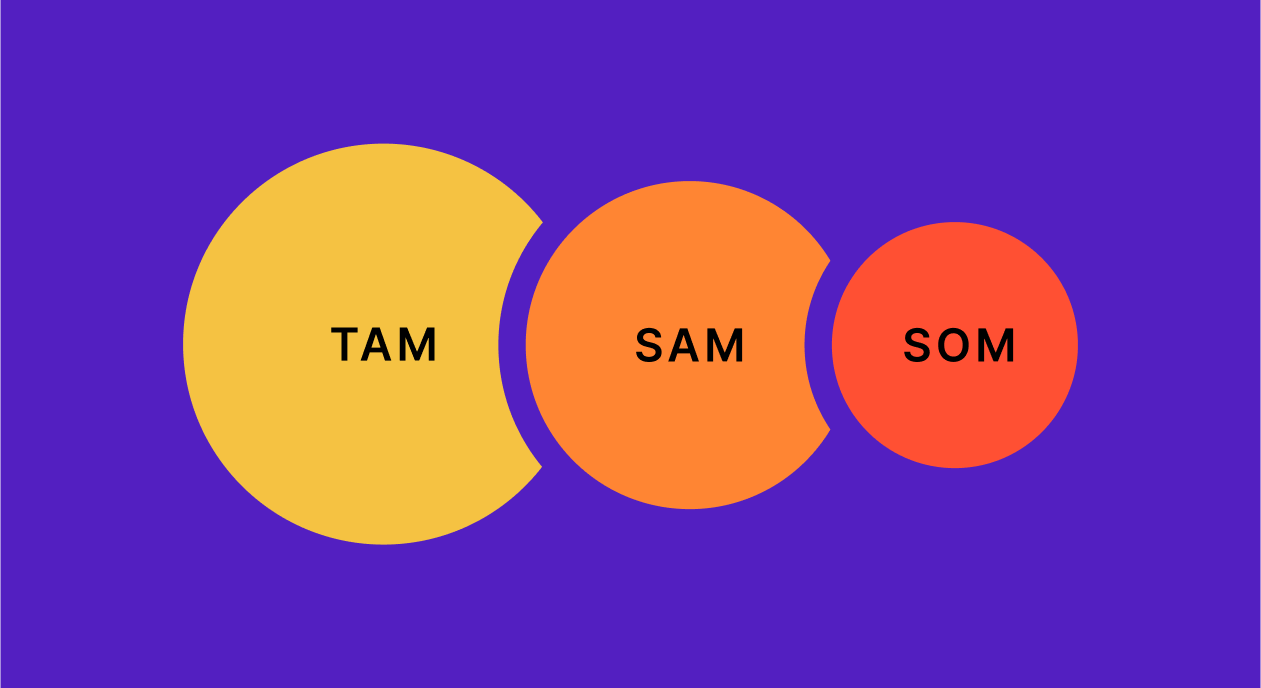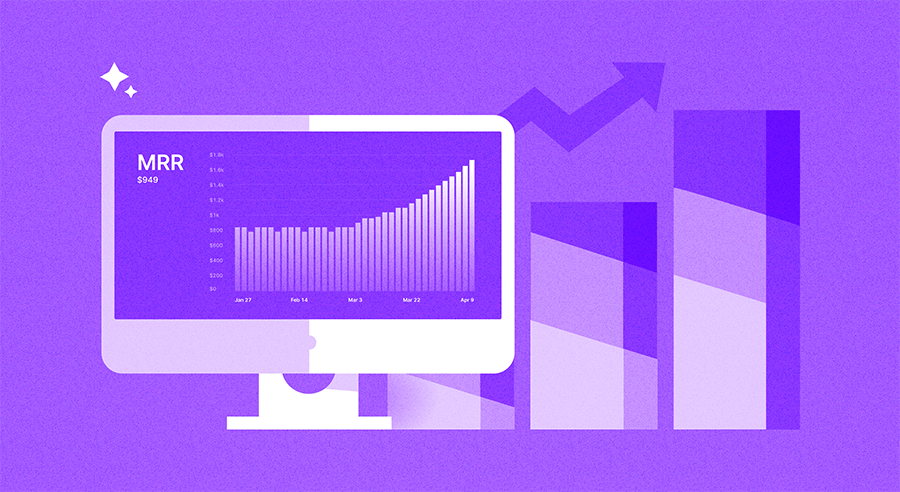If you want to answer questions like how many users might be potentially looking for a mobile app like yours, how many of those you could actually cater to, and just how many of them you can actually convert, you’ll find your answers with market sizing.
And at the core of market sizing lie TAM (Total Addressable Market), SAM (Serviceable Addressable Market), and SOM (Serviceable Obtainable Market) analyses. TAM, SAM, and SOM analyses give you insights that can help you:
- Set realistic goals for your mobile app.
- Plan sales and marketing strategies.
- Adjust them as needed for sustainable growth.
So let’s understand TAM, SAM, and SOM analyses, how they apply to mobile apps, and how to calculate them!
Here goes.
What is TAM?
TAM – Total Addressable Market or Total Available Market – represents the market or “opportunity” available for your mobile app. For example, if you’re looking to launch a meditation mobile app, then your target market comprises people going through all kinds of conditions like stress, anxiety, and depression. You’re also looking at people looking for better mental health or mood. Finally, you’ll also cater to users specifically seeking help with mindfulness therapies like meditation.
As you can see, you zoom out when you look at TAM. For example, the revenue potential for a meditation mobile app, if it captures the whole TAM, would be 7.25 billion U.S. dollars by 2033, according to Statista. Because that’s how big the market for meditation apps is projected to get.
On a side note, when you want to perform TAM analysis, tapping resources like Statista and industry publications can help a lot. They offer the latest data and projections, which is enough at the TAM stage.
Back to TAM… So, as you can see, you aren’t very concerned about any granular details when working with TAM. In general, TAM tells you three things:
- TAM tells you your app’s overall opportunity. When planning a new app, you want to be sure there’s a market for it. TAM tells you just that. When performing TAM analysis, it’s important to remember that TAM doesn’t use any filters, so the market size it suggests isn’t your actual market. SAM helps define the actual market, as we’ll see in the next section.
- TAM, by itself, is too broad. Because TAM looks at the market theoretically, it’s crucial to consider SAM along with it, which provides a more realistic view of your app’s potential market .
- TAM tells you how your target market could look if your app evolved into a more mature solution. Adding PAM – Potentially Addressable Market – analysis on top of your TAM analysis can give ideas as to how your app could have a bigger target market than you initially estimated. For example, if, at some point, this meditation app from our example expanded to include online therapy, then this app could target even more users.
What is SAM?
SAM – Serviceable Addressable Market or Serviceable Available Market – represents the market that you can actually target. To arrive at SAM, you apply filters to your TAM analysis and eliminate user populations that TAM included in your addressable market, but that don’t really belong to it.
Let’s return to our meditation app example. Here are a few considerations we’d use for deducing the actual Service Addressable Market from its Total Addressable Market:
- Suppose this app is to be available only in the U.S. This means the app’s TAM shrinks to represent the market available in the U.S. alone.
- Since this app only offers meditation, filtering at the feature level makes sense. For example, SAM would be the subset of the total U.S. population actively seeking or using a meditation app. So you might want to consider 12% of the total U.S. population to be your SAM, as this population uses a mobile app to help with meditation. (Note: Again, resources like Statista help with SAM analysis.)
- Next, let’s say this is an iPhone app. This further excludes Android users from the growth calculations.
You get the drift.
Your SAM is always a small percentage of your TAM. And in one way, your SAM is actually your TAM, because, in reality, it is the one that truly represents the available market. Also, while there’s no industry standard, some resources claim SAM to be generally about 1-10% of TAM.
- Depending on your app, you can have a small or big SAM, but a small SAM isn’t necessarily a problem. A niche app will naturally have a much smaller SAM than apps targeting broader populations.
- SAM helps you frame your monetization model. If you have a niche app, you’re looking at a significantly small addressable user population or SAM. This means even if you reach a respectable user base, you’ll still not be looking at hundreds of thousands of users. If you use a strictly subscription-based monetization model for such an app, then you may limit your revenue potential. A hybrid monetization model could offer a better average revenue per user… and increase revenue.
- SAM evolves as your app evolves. As you start offering your app through additional channels (for example, adding your app to the Play Store, too, after initially only launching it in the App Store), regions, or languages, your SAM expands. Not just that, even if your app evolves into something bigger – for instance, if you start as a meditation app and eventually grow to become a full mindfulness app – you’ll see that your addressable market increases, too.
What is SOM?
SOM – Serviceable Obtainable Market – represents the market that you can actually expect to target to convert. To calculate your SOM , you would need to consider factors such as market trends, the competitive landscape, and potential customer interest in your specific app. Unlike SAM, SOM considers your business’s realistic constraints and limitations, such as budget, resources, and capabilities. By understanding your SOM, you can set more achievable and accurate revenue goals for your mobile app.
For our meditation app example, estimating SOM would mean looking at the following factors:
- The app’s competitive landscape: The most popular apps in any niche own most of the market share and revenue. So to start with, especially if you’re going after a competitive, money-making app niche, you need to understand the market share that you can realistically capture, given the shares that the most popular apps already own. If 95% of your app’s SAM already uses a leading meditation app for their meditation, you’re looking at a much smaller market. Factoring in the competition helps you calculate your SOM more realistically.
- Your marketing bandwidth. With SAM analysis, you’ll know exactly the market you can reach. But your marketing bandwidth plays a role in whether you can effectively reach the identified market share. If you have limited resources for marketing, your SOM may be smaller than initially anticipated.
- Consumer behavior. Your market’s buying behavior also influences you SOM. To estimate SOM, you must know what percent of your identified market will be willing to spend money on a mobile app (as that’s the share you’re after). Looking at the share of paying users across your niche can help estimate this. You’d need to understand your market’s general retention patterns as they tell how loyal your market can be. You might have to invest in research to find these out.
Macro trends would be another important consideration. Macro trends can also impact your estimation of SOM, as shifts in the economy or industry can affect consumer spending habits. It’s important to consider these external factors when projecting your market share.
Market Sizing for a mobile app using TAM, SAM, and SOM analyses
Adding TAM, SAM, and SOM analyses to your app marketing forces you to critically evaluate constraints like your funding and competition, allowing you to set realistic goals. These analyses also help position your app for sustainable growth by avoiding reliance on generalizations.
TAM, SAM, and SOM analyses continue to offer value even as your app evolves. As your app grows, you might see that your SOM is growing to include more of your SAM — for example, when more users learn about your app.
Not just that, you might even decide to optimize your SAM by offering your app in more languages — by expanding to non-English speaking markets, for instance.
You may also discover that your TAM is larger than initially anticipated, leading to new opportunities for expansion.
In all, TAM, SAM, and SOM analyses can give a roadmap for strategic decision-making at all stages of an app’s growth funnel.
Let’s now see how you can perform TAM, SAM, and SOM analyses for your app.
How to calculate your mobile app’s TAM, SAM, and SOM
Using the top-down approach
In the top-down approach to estimating TAM, SAM, and SOM, you start by including everyone who could potentially use your app in your TAM analysis.
Then, you narrow it down to SAM by considering factors like demographics, geographic location, and purchasing power.
Finally, you further refine it to SOM by factoring in your app’s unique value proposition and the competitive landscape.
The top-down approach for calculating TAM, SAM, and SOM analyses allows you to estimate your app’s market potential without relying on specific data, making it a handy tool for preliminary analysis. However, for the same reason, the top-down approach will almost always produce market sizing that may not reflect the real-world market because it relies heavily on broad assumptions and generalizations. So, validating these estimates with real data is important as you progress further into your business planning process.
Using the bottom-up approach
In the bottom-up approach to estimating TAM, SAM, and SOM, you start by calculating your SOM based on your existing user base. If you use a revenue management solution like Adapty for your app, you probably already know who your paying users or subscribers are.
If your app is new or you don’t have enough sales data, define targeted segments that represent potential paying users using filters for demographics, behavior patterns, and geographic locations.
Next, estimate your SAM by adding realistically accessible users, building from your known segments.
Finally, expand to TAM by including all potential users.
This method provides a more accurate market estimate since it’s based on real data or targeted segments, unlike the top-down approach that relies on broad assumptions. This leads to a more precise and realistic market analysis.
Wrapping it up…
Conducting thorough TAM, SAM, and SOM analyses helps you realistically understand your app’s growth potential. For many niche apps, calculating TAM, SAM, and SOM might show that the app may only reach a few thousand subscribers, which isn’t a bad thing at all if the market is actually willing to commit to subscriptions.
But remember that these numbers can change over time as the market evolves and user preferences shift. It’s important to regularly reassess and update your market sizing analysis.
And as we saw, the bottom-up approach tends to be more accurate. Since the bottom-up approach to estimating your TAM, SAM, and SOM needs your user spending behavior data, consider adding a revenue analytics solution like Adapty to your app. This way, you’ll get a really accurate picture of your SOM and eventually your SAM and TAM. Check out Adapty.




